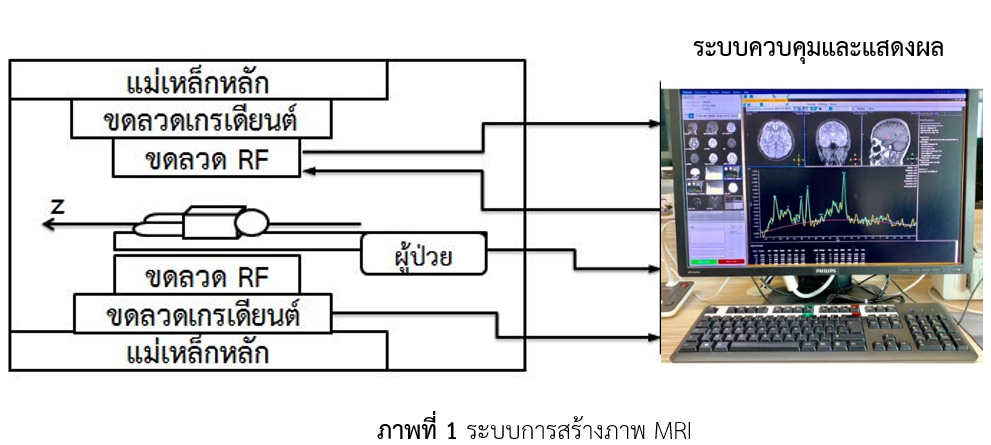การจำลองการสร้างภาพการสั่นพ้องแม่เหล็กของโปรตอนใน 2 มิติ
Main Article Content
บทคัดย่อ
วัตถุประสงค์ของงานวิจัยนี้เพื่อจำลองการสร้างภาพการสั่นพ้องแม่เหล็กของโปรตอนใน 2 มิติ โดยออกแบบและเขียนโปรแกรมจำลองวัตถุตัวอย่าง คำนวณการสร้างภาพ k-space และคำนวณการสร้างภาพคืน โดยใช้โปรแกรม Visual C# วัตถุตัวอย่างแทนด้วยความเข้มของจุดภาพพื้นที่หน้าตัดของหลอดตัวอย่างบรรจุสารละลาย จำนวน 3 หลอด ที่ยาวเท่ากันมัดติดกัน มีขนาดเส้นผ่าศูนย์กลางของแต่ละหลอดเท่ากับ 20 mm ให้สัดส่วนของความเข้มของภาพในแต่ละหลอดเป็น 1 : 2 : 3 โดยความเข้มของจุดภาพในแต่ละหลอดตัวอย่างแทนความหนาแน่นของโปรตอน ในการคำนวณ ได้ใช้บริเวณในการสร้างภาพ (FOV) เป็น 50×50 mm2 และใช้ความละเอียดของภาพเป็น 128 × 128 จุดภาพ ในงานวิจัยนี้ ได้คำนวณการสร้างภาพ k-space จากการแปลงฟูเรียร์ และการสร้างภาพคืนจากการแปลงฟูเรียร์กลับ โดยใช้เงื่อนไขการสร้างภาพการสั่นพ้องแม่เหล็กของโปรตอนใน 2 มิติ ผลการคำนวณ พบว่า ภาพ k-space ของวัตถุจำลองที่ได้ให้ภาพที่ชัดเจน และภาพที่คำนวณได้ในกระบวนการสร้างภาพคืน มีสัดส่วนความเข้มของภาพสอดคล้องกับความเข้มของภาพวัตถุตัวอย่าง แต่มีคมชัดของภาพลดลงเล็กน้อย เนื่องจากความเข้มของสีบางส่วนในภาพk-space หายไปในระหว่างการแปลงค่าตำแหน่งจากการแปลงฟูเรียร์กลับ นอกจากนี้ ในการสร้างภาพคืนมีการเกิดภาพซ้อนกับภาพตรงข้ามที่อยู่นอก FOV แต่ยังสามารถแก้ไขได้โดยการปรับขนาดของภาพ k-space ให้ตรงกับขนาดของภาพที่ได้จากการสร้างภาพคืนโดยการปรับระยะของข้อมูลในแนวแกน kx และระยะของข้อมูลในแนวแกน ky ให้สอดคล้องกับระยะของข้อมูลในแนวแกน และระยะข้อมูลในแนวแกน y ตามลำดับ
Article Details
วารสารวิทยาศาสตร์และวิทยาศาสตร์ศึกษา (JSSE) เป็นผู้ถือลิสิทธิ์บทความทุกบทความที่เผยแพร่ใน JSSE นี้ ทั้งนี้ ผู้เขียนจะต้องส่งแบบโอนลิขสิทธิ์บทความฉบับที่มีรายมือชื่อของผู้เขียนหลักหรือผู้ที่ได้รับมอบอำนาจแทนผู้เขียนทุกนให้กับ JSSE ก่อนที่บทความจะมีการเผยแพร่ผ่านเว็บไซต์ของวารสาร
แบบโอนลิขสิทธิ์บทความ (Copyright Transfer Form)
ทางวารสาร JSSE ได้กำหนดให้มีการกรอกแบบโอนลิขสิทธิ์บทความให้ครบถ้วนและส่งมายังกองบรรณาธิการในข้อมูลเสริม (supplementary data) พร้อมกับนิพนธ์ต้นฉบับ (manuscript) ที่ส่งมาขอรับการตีพิมพ์ ทั้งนี้ ผู้เขียนหลัก (corresponding authors) หรือผู้รับมอบอำนาจ (ในฐานะตัวแทนของผู้เขียนทุกคน) สามารถดำเนินการโอนลิขสิทธิ์บทความแทนผู้เขียนทั้งหมดได้ ซึ่งสามารถอัพโหลดไฟล์บทความต้นฉบับ (Manuscript) และไฟล์แบบโอนลิขสิทธิ์บทความ (Copyright Transfer Form) ในเมนู “Upload Submission” ดังนี้
1. อัพโหลดไฟล์บทความต้นฉบับ (Manuscript) ในเมนูย่อย Article Component > Article Text
2. อัพโหลดไฟล์แบบโอนลิขสิทธิ์บทความ (Copyright Transfer Form) ในเมนูย่อย Article Component > Other
ดาวน์โหลด ไฟล์แบบโอนลิขสิทธิ์บทความ (Copyright Transfer Form)
เอกสารอ้างอิง
Alecci, M., Ferrai, M., Quaresima, V., Sotgiu, A. and Ursini, C.L. (1994). Simultaneous 280 MHz EPR imaging of rat organs during nitroxide free radical clearance. Biophysical Journal, 67, 1274-1279.
Bracewell, R.N. (1986). The Fourier transform and its applications. New York: McGraw-Hill.
Bushong, S.C. (1988). An overview of magnetic resonance imaging, In D.T. Culverwell (Ed.). Magnetic resonance imaging: physical and biological principles. (pp. 1-17). Missouri: The C.V. Mosby Company.
Eaton, S.S. and Eaton, G.R. (1984). EPR imaging. Journal of Magnetic Resonance, 59, 474-477.
Edelstein, W.A., Hutchison, J.M.S, Johnson, G. and Redpath T. (1980). Spin warp NMR imaging and applications to human whole-body imaging. Physics in Medicine and Biology, 25, 751-756.
Gallagher, T.A., Nemeth, A.J. and Hacein-Bey L. (2008). An introduction to the Fourier Transform: Relationship to MRI. American Journal of Roentgenology, 190(5), 1396-405.
Hashemi, R.H., Lisanti, C.J. and Bradley Jr.W.G. (2017). MRI: The Basics, 4th Eds. Philadelphia: Wolters Kluwer.
Pruessmann, K.P., Weiger, W., Scheidegger, M.B. and Boesiger P. (1999). SENSE: Sensitivity encoding for fast MRI. Magnetic Resonance in Medicine, 42, 952-962.
Li, H., Deng, Y., He, G., Kuppusamy, P., Lurie, D.J. and Zweier, J.L. (2002). Proton-electron double-resonance imaging of the in vivo distribution and clearance of a triaryl methyl radical in mice. Magnetic Resonance in Medicine, 48, 530-534.
Lurie, D.J., Foster, M.A., Yeung, D. and Hutchison, J.M.S. (1998). Design, construction and use of a large-sample field- cycled –PERDI imager. Physics in Medicine and Biology, 43, 1877-1886.
Moratal, D., Vallés-Luch, A., Martí-Bonmatí, L. and Brummer, M.E. (2008). k-Space tutorial: An MRI educational tool for a better understanding of k-space. Biomedical Imaging and Intervention Journal, 4(1), e15.
Partain, C.L., Price, R.R., Patton, J.A., Kulkarni, M.V. and James, A.E. (1988). Magnetic Resonance Imaging. Philadelphia: W.B. Saunder Company.
Preston, D.W. and Dietz, E.R. (1991). The art of experimental physics: Introduction to magnetic resonance. Toronto: Wiley and Sons.
Polyon C., Lurie D.J., Youngdee W., Thomas C. and Thomas I. (2008). Comparison of 14N and 15N nitroxide free radicals Imaged by Field-Cycled Proton-Electron Double-Resonance Imaging (FC-PEDRI) at Low Magnetic Field. Thai Journal of Physics, 3, 122-124.
Puwanich, P., Lurie, D.J. and Foster, M.A. (1999). Rapid imaging of free radicals in vivo using field–cycled PEDRI. Physics in Medicine and Biology, 44, 2867-2877.
Testa, L., Gualtieri, G. and Sotgiu, A. (1993). Electron paramagnetic resonance imaging of a model of a beating heart. Physics in Medicine and Biology, 38, 259-266.


